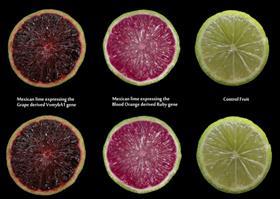
University of Florida horticulture scientist Manjul Dutt and Jude Grosser from the UF Citrus Research and Education Center are developing genetically engineered limes containing some similar genetic factors that are expressed in grape skin and blood orange pulp.
According to a release from the University, these modified Mexican limes have a protein that induces anthocyanin biosynthesis, the process that creates the 'red' in red wine, and causes the limes to develop a range of colours in the pulp from dark purple to fuchsia.
“Anthocyanins are beneficial bioflavonoids that have numerous roles in human well-being,” Dutt explained. “Numerous pharmacological studies have implicated their intake to the prevention of a number of human health issues, such as obesity and diabetes.”
Anthocyanins also naturally occur in a variety of oranges called blood oranges, which has a red to maroon coloured flesh and, some say, a better taste than Florida’s 'blond' oranges. But blood oranges need cold temperatures to develop their trademark vibrant colour. They grow and colour well in the cooler climates of Spain and Italy, but do not exhibit the characteristic blood red colour when grown in the subtropical climate of the Florida citrus belt.
The new limes were developed using genes isolated from the red grape 'Ruby Seedless' and the Blood Orange 'Moro'. Research on the utilisation of these genes was conducted initially to develop a more consumer-friendly, alternative, plant-derived, system. They are the first step toward Florida farmers producing blood oranges and, possibly, a new grapefruit cultivar.
In addition to changing the colour of the fruit, the introduction of anthocyanins also change the colour of leaves stems and flowers, and could lead to the creation of ornamental citrus plants.
“Novel fruit, leaf, and flower colours could be produced by regulating anthocyanin biosynthesis,” Dutt said. “Flower colour ranged from light pink to fuchsia.”
Dutt and Grosser’s study is being published in the January edition of the Journal of the American Society for Horticultural Science.



